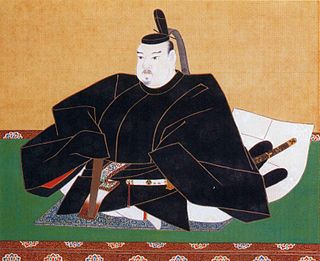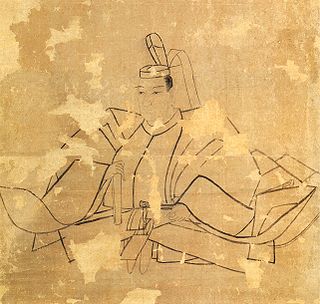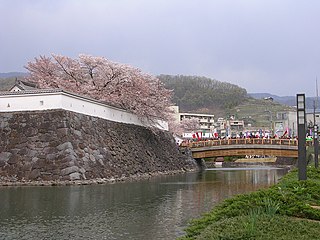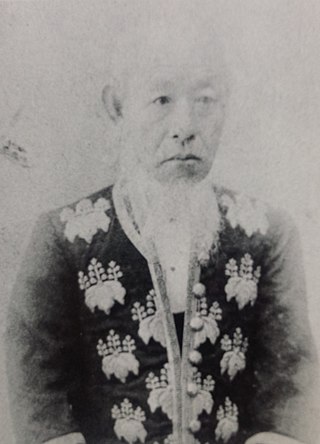Related Research Articles

Sen no Rikyū, also known simply as Rikyū, is considered the historical figure with the most profound influence on chanoyu, the Japanese "Way of Tea", particularly the tradition of wabi-cha. He was also the first to emphasize several key aspects of the ceremony, including rustic simplicity, directness of approach and honesty of self. Originating from the Sengoku period and the Azuchi–Momoyama period, these aspects of the tea ceremony persist. Rikyū is known by many names; for consistency, he will be referred to as Rikyū in this article.

Tokugawa Iemitsu was the third shōgun of the Tokugawa dynasty. He was the eldest son of Tokugawa Hidetada with Oeyo, and the grandson of Tokugawa Ieyasu. Lady Kasuga was his wet nurse, who acted as his political adviser and was at the forefront of shogunate negotiations with the Imperial court. Iemitsu ruled from 1623 to 1651; during this period he crucified Christians, expelled all Europeans from Japan and closed the borders of the country, a foreign politics policy that continued for over 200 years after its institution. It is debatable whether Iemitsu can be considered a kinslayer for making his younger brother Tadanaga commit suicide by seppuku.

Tokugawa Tsunayoshi was the fifth shōgun of the Tokugawa dynasty of Japan. He was the younger brother of Tokugawa Ietsuna, as well as the son of Tokugawa Iemitsu, the grandson of Tokugawa Hidetada, and the great-grandson of Tokugawa Ieyasu.

Tokugawa Ietsuna was the fourth shōgun of the Tokugawa dynasty of Japan who was in office from 1651 to 1680. He is considered the eldest son of Tokugawa Iemitsu, which makes him the grandson of Tokugawa Hidetada and the great-grandson of Tokugawa Ieyasu.
Ōoku (大奥) is a Japanese drama produced by FujiTV. The story is set in the Edo period and is fiction set against a background of historical fact. The Ōoku was the part the ladies lived in Edo Castle.

Engelbert Kaempfer from Lemgo was a German naturalist, physician, explorer and writer known for his tour of Russia, Persia, India, Southeast Asia, and Japan between 1683 and 1693.

Yanagisawa Yoshiyasu was a Japanese samurai of the Edo period. He was an official in the Tokugawa shogunate and a favourite of the fifth shōgun, Tokugawa Tsunayoshi. His second concubine was Ogimachi Machiko, a writer and scholar from the noble court who wrote monogatari.

A kago (駕籠) is a type of litter used as a means of human transportation by the non-samurai class in feudal Japan and into the Meiji period (1868–1911).

Genroku (元禄) was a Japanese era name after Jōkyō and before Hōei. The Genroku period spanned the years from the ninth month of 1688 to the third month of 1704. The reigning emperor was Emperor Higashiyama (東山天皇).

Tenna (天和) was a Japanese era name after Enpō and before Jōkyō. This period spanned the years from September 1681 through February 1684. The reigning emperor was Reigen-tennō (霊元天皇).

Manji (万治) was a Japanese era name after Meireki and before Kanbun. This period spanned the years from July 1658 through April 1661. The reigning emperor was Go-Sai-tennō (後西天皇).
Kajikawa Yoriteru was a Japanese samurai of the Edo period, who served as a lesser official in the Tokugawa shogunate. He was also known as Kajikawa Yosōbei. Kajikawa served on guard duty in Edo Castle.
Sakai Tadakiyo, also known as Uta-no-kami, was a daimyō in Kōzuke Province, and a high-ranking government advisor and official in the Tokugawa shogunate of Japan.

Kōfu Castle was a Japanese castle located in the city of Kōfu, Yamanashi Prefecture, in the Chubu region of Japan. The site has been protected as a National Historic Site since 2019. The castle is also known as Maizuru Castle, and the present-day surroundings are called Maizuru Castle Park.
Inaba Masayasu was a Japanese hatamoto and daimyō of Aono han in Mino Province in Edo period Japan. Masayasu's family was descended from Konō Michitaka.

Kurokawa Domain was a fudai feudal domain under the Tokugawa shogunate of Edo period Japan. It is located in Echigo Province, Honshū. The domain was centered at Kurokawa Jin'ya, located in what is now part of the city of Tainai in Niigata Prefecture.

Nagasaki bugyō (長崎奉行) were officials of the Tokugawa shogunate in Edo period Japan. Appointments to this prominent office were usually fudaidaimyōs, but this was amongst the senior administrative posts open to those who were not daimyōs. Conventional interpretations have construed these Japanese titles as "commissioner", "overseer" or "governor".
Ogasawara Nagashige, also known as Sado-no-kami or Etchū-no-kami, was a Japanese samurai daimyō of the mid-Edo period.

Inaba Masanari, also known as Inaba Masashige and sometimes known as Mino-no-kami, was a Japanese samurai of the Azuchi–Momoyama period through early Edo period. He served the Oda, Toyotomi, and Tokugawa clans, and became a daimyō in the early Edo period.
Ōgimachi Machiko was a Japanese noble lady, scholar, member of the Ōgimachi family of court nobles during the Edo period. She is known for her diary, Matsukage no nikki, which details numerous events of that period in a writing style inspired by the Tale of Genji.
References
- ↑ WorldCat (date unknown). Beatrice M. Bodart-Bailey. Retrieved from http://experiment.worldcat.org/entity/person/data/2632104239.
- 1 2 3 4 5 Kenrick, Vivienne (2006-06-24). "Personality Profile: Beatrice M. Bodart-Bailey". Japan Times (Tokyo), 24 June 2006. Retrieved on 2011-05-14 from http://search.japantimes.co.jp/cgi-bin/fl20060624vk.html.
- 1 2 3 4 Asiatic Society of Japan, Beatrice Bodart-Bailey; retrieved 2011-05-14
- ↑ WorldCat Identities Archived December 30, 2010, at the Wayback Machine : Bodart-Bailey, Beatrice M.